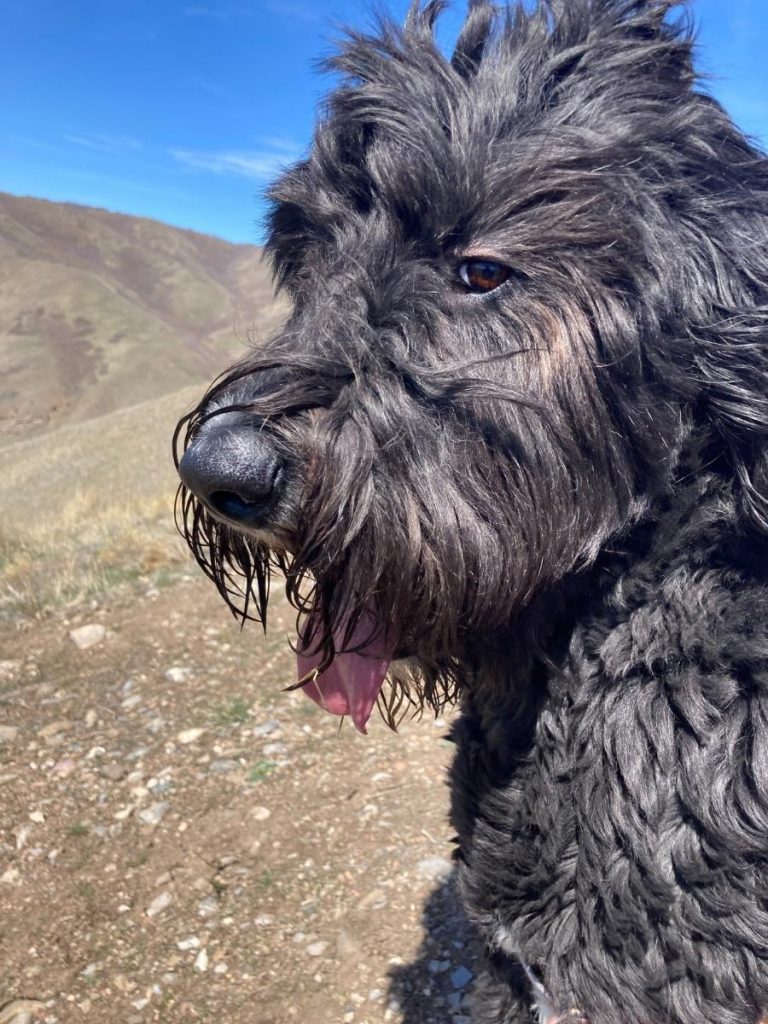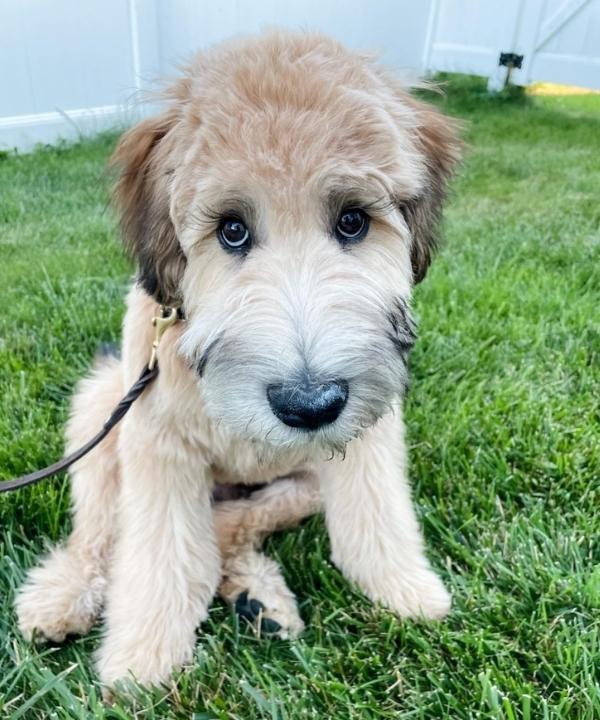A Doodle breed, or Doodle dog, is a mix of any dog with a Poodle. Doodles have become wildly popular in modern society and for good reason. If you’re looking for a new family pet, these adorable, lovable, fluffy-haired cuties may just be the perfect fit.
In this article, I’ll cover a host of topics regarding Doodle dogs such as history, popularity, traits, and the many different types of Doodle breeds. By the end, you will be a Doodle dog expert and ready to find the best Doodle breed for you!
Before I start, I will issue a fair warning that by the end you may find yourself searching for Doodle puppies or Doodle dogs for adoption!
Introduction
I’ll never forget the first time I laid eyes on a Doodle dog. It was absolute fluffy mayhem and I just couldn’t peel my eyes away. There were two of them actually, walking side-by-side on a college campus in the Midwest. I couldn’t let these curly-haired cuties slip by me without figuring out what exactly they were.
It turns out they were both Bernedoodles. I ran my hand through their soft, curly coat while talking with the owner. I walked away from those giant fluff muffins as a changed man. I was determined to buy a Doodle dog as soon as I graduated from college.
And oh boy, you bet I bought one. Five years after my initial Doodle meeting, I got Murphy, my sweet, rambunctious Bernedoodle.
Enough about me. This article is the answer to the question I had many years ago when I first stumbled upon those two Bernedoodles: What exactly are Doodle dogs and how did they become one of the most popular breeds around the world?
Let’s jump right in!
What Makes a Doodle Dog?
The first thing you need to know about Doodle dogs is that they’re not technically an official breed. Instead, they’re a group of hybrid dogs resulting from crossing or mixing a Poodle with other dog breeds.
Since the Poodle is a staple breed in any Doodle dog, all Doodle breeds have some mutual features that they inherit from their Poodle parent. This manifests most apparently in their curly/wavy coat, intelligence, and athletic build.
Historically, Doodle dogs have been bred for various reasons. The most common reason is the intent to avoid genetic, or hereditary, problems seen in purebred dogs. As a mixed breed, Doodles take advantage of inheriting the good traits from both parent breeds.
Poodles can be bred with any other dog breed to create a Doodle. As a result, there are many different types of Doodle dogs.
Other Names
Poodle mixes are referred to by other names besides just “doodle”. Although “doodle” is the most common term used to describe poodle mixes, some use the suffix “Poos” to describe a Doodle dog.
This is the case with a “Chipoo”, which is a Poodle mixed with a Chihuahua. Another example would be a “Peekapoo”, which is a Poodle mixed with a Pekingese. Both are still considered Doodles.
Poodle mixes can also be regarded by removing the “d” from “doodle” and just using the suffix “oodle”. For example, a “Whoodle” is a Poodle mixed with a Soft-Coated Wheaten Terrier.
Ancestry
Any dog is considered a Doodle as long as one of its ancestors was a Poodle. It does not necessarily matter when the Poodle ancestor was mixed with a different dog breed.
There are different generations that Doodles are classified in, which are denoted using the letter “F”. This stands for filial, which in biology “denotes the generation after the parental generation”.
F1
Purebred Dog x Purebred Poodle = F1 Doodle
F1 represents the first generation of a purebred dog mixed with a purebred Poodle. So if you crossed a purebred Poodle with a purebred Newfoundland, you would get an F1 Newfiedoodle. The dog would be 50% Poodle and 50% Newfoundland (and 100% cute).
F2
F1 Doodle x F1 Doodle = F2 Doodle
F2 represents the second generation of a purebred dog mixed with a purebred Poodle. So if you crossed an F1 Newfiedoodle with another F1 Newfiedoodle, you would get an F2 Newfiedoodle. This means the dog would still be 50% Poodle and 50% Newfoundland (and 100% cute).
As you might imagine, this leads on to more generations as the levels of breeding are mixed, but since this is not a high school biology class I will press forward.
Origin and History of Doodles
While many dog breeds have a rich history that dates back centuries, the Doodle breed is still in its adolescence. Their story begins in the last century.
Although the true origin of the first-ever Doodle dog is unknown, several well-documented points in modern history play an important role in the rise of this particular dog breed.
1955: The First Labradoodle
The first use of the word “doodle” to describe a Poodle mix was by Sir Donald Campbell, who owned a Poodle-Labrador mix, or Labradoodle, during the mid-1950s.
In 1955, Campbell released his book “Into The Water Barrier”, in which he used the word “Labradoodle” to describe his dog, Maxie. However, the word “doodle” wasn’t adopted to describe Poodle mixes until later on.
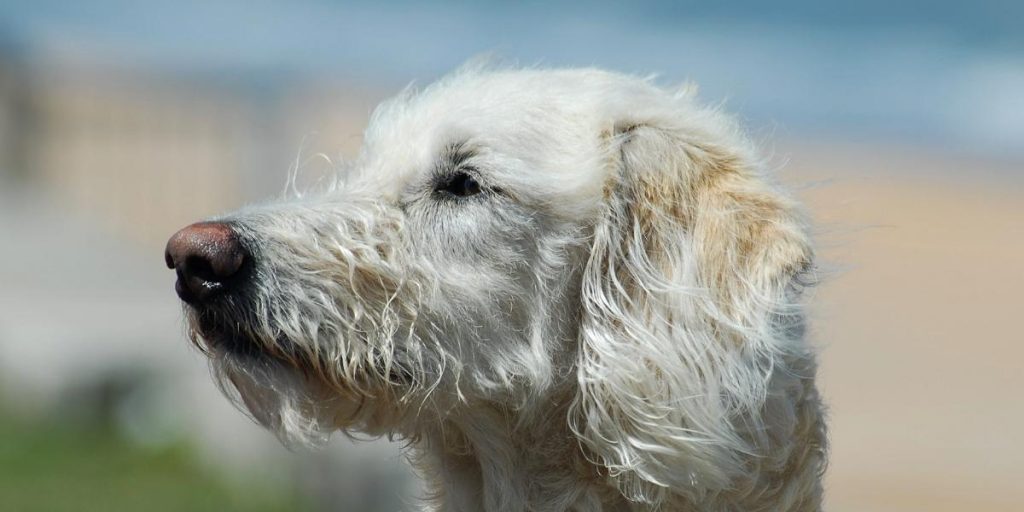
1969: Deliberate Cross-Breeding of Poodles
Although it’s nearly impossible to track the first time Poodles were deliberately crossbred with other dog species, the first recorded incident that we know of was by Monica Dickens. If the name rings any bells, you’re correct, she’s Charles Dickens’ great-granddaughter!
Dickens deliberately crossbred Poodles with Golden Retrievers, Goldendoodles, as an alternative to the use of Labradors in the late 1960s. She found the resulting dog to be healthier than both parents [1]https://www.ncbi.nlm.nih.gov/pmc/articles/PMC6940824/.
1989: Doodles Introduced As a Service Dog
The year 1989 was iconic for Doodle dogs. It is the year when the first officially recognized Doodle breed was introduced.
In that year, Wally Conron, a dog breeder who worked for the Victoria Royal Guide Dog Association of Australia, created the first Doodle in an effort to provide a hypoallergenic service dog.
This cross-breed came as a result of a letter he received from a couple in Hawaii. The husband needed a guide dog but he was sensitive to dog allergens.
Conron realized that the low-shedding coat of the Poodle could be the solution they were looking for. He bred the Poodle with a Labrador Retriever due to the Labrador’s highly desirable traits of companionship and obedience.
The resultant Labradoodle litter produced a dog named “Sultan”, who was exactly what Conron and the couple were looking for. Sultan went on to serve as the husband’s guide dog couple for over a decade!
The success of this Labradoodle guide dog caught the eye of many and served as the catalyst for the Doodle breed as a whole.
1990s: The Doodle Breakthrough
Historically, dog owners desired only purebreds to serve as the family pup. Of course, mixes and mutts were common but they weren’t necessarily sought after.
However, the take on mixed dogs slowly started to change as research began to show the health benefits that resulted from mixing two different dog breeds. Cross-breeding helps mitigate the risk of inheriting breed-specific diseases.
Doodles benefit from cross-breeding and are also unbelievably adorable. These two factors grabbed the attention of many in the 1990s.
As I covered earlier, the Labradoodle was the first ‘documented’ Doodle. It is not a coincidence that the Labradoodle was the first Doodle breed since the Labrador Retriever has been a beloved breed for decades.
In fact, the Labrador Retriever is the most popular dog breed in America, and it has been for the past 30 years! Therefore, the Labradoodle paved the way for Doodle breeds to have a meteoric rise in popularity as the new family pet.
Modern Day Popularity
Since the early 2000s, Doodle dogs have taken the world by storm. For example, the sheer number of daily Instagram posts for a few different types of Doodle breeds is mind-blowing.

Based on the numbers above, it is safe to say that Doodles are #trending. Even big-name celebrities and athletes have hopped on the Doodle train.
- Usher has an adorable Goldendoodle named Scarlett.
- One of Tiger Woods’ first dogs was a white Labradoodle named Yogi.
- Kenney Chesney has a cute Goldendoodle named Pancho.
If you’ve spent any time on social media, or even just taken a walk around the neighborhood, odds are you’ve come across one of these cute, curly-haired dogs. Doodles seem to be taking over sidewalks and local dog parks as their popularity continues to grow.
Some people believe their popularity can be attributed to the catchy, marketable name “Doodle” that was brought to the public’s attention by Conron’s project. Others attribute popularity to their favorable traits and characteristics.
In the next section, I’ll explore some of the characteristics that make Doodle dogs stand out from the pack.
Physical Appearance of Doodle Dogs
In this section, I’ll discuss the different components that make up Doodle’s physical appearance such as coat type, fur color, and size.
Coat
Arguably, the most defining feature of a Doodle dog is its coat. It is usually relatively easy to spot a Doodle in the wild because of their iconic coats. Poodles have dense, curly fur; so when they are crossed with other breeds, the resulting dog has the potential for a striking coat of fur that can be wavy, curly, straight, and/or wiry.
The specific type of coat a Doodle may have is based on genetics and breeding selection. The gene pool that is passed on from the parents is the main driver that determines coat type. Therefore, coat type will vary across different types of Doodle dogs. It can also vary across the same litter.
Wavy
Wavy coats are the result of a gene interaction between the straight hair allele (R) and curly hair allele (r) for coat types in dogs. It is represented by: R/r [2]https://www.ncbi.nlm.nih.gov/pmc/articles/PMC2897713/.
Wavy coats are sometimes lumped into the ‘curly-coat’ genre; however, they are not one in the same. It is simpler to separate the two types, especially when classifying Doodle coats because not all curls are created equal!
Wavy-coats do indeed have curls but not the type that is present on Poodles, which are numerous and tight. Wavy fur has much looser curls that are less in number along with regions of semi-straight fur. This creates a pattern that resembles waves, or ripples.
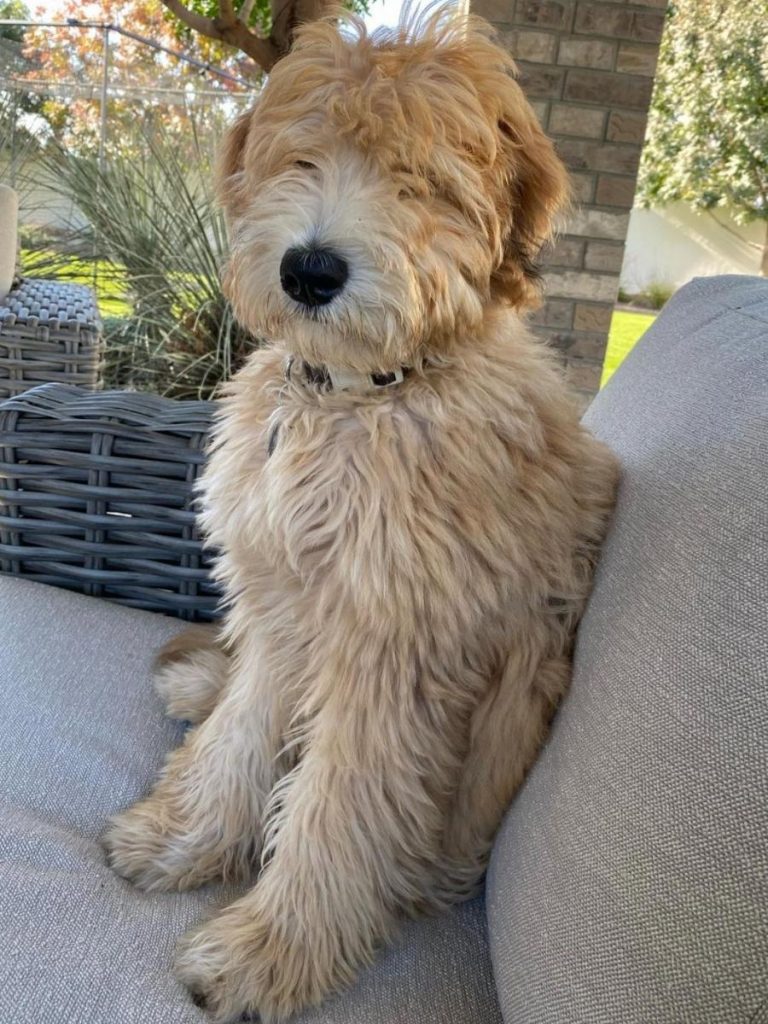
Curly
Curly coats are the result of a gene interaction between a pair of curly hair alleles (r), which is represented by: r/r [3]https://www.ncbi.nlm.nih.gov/pmc/articles/PMC2897713/
Curly coats have dense, tight-knit curls throughout. This type of coat is apparent in the Poodle dog breed, as seen below.
The Goldendoodle pictured below is a perfect representation of a Doodle with a curly coat.
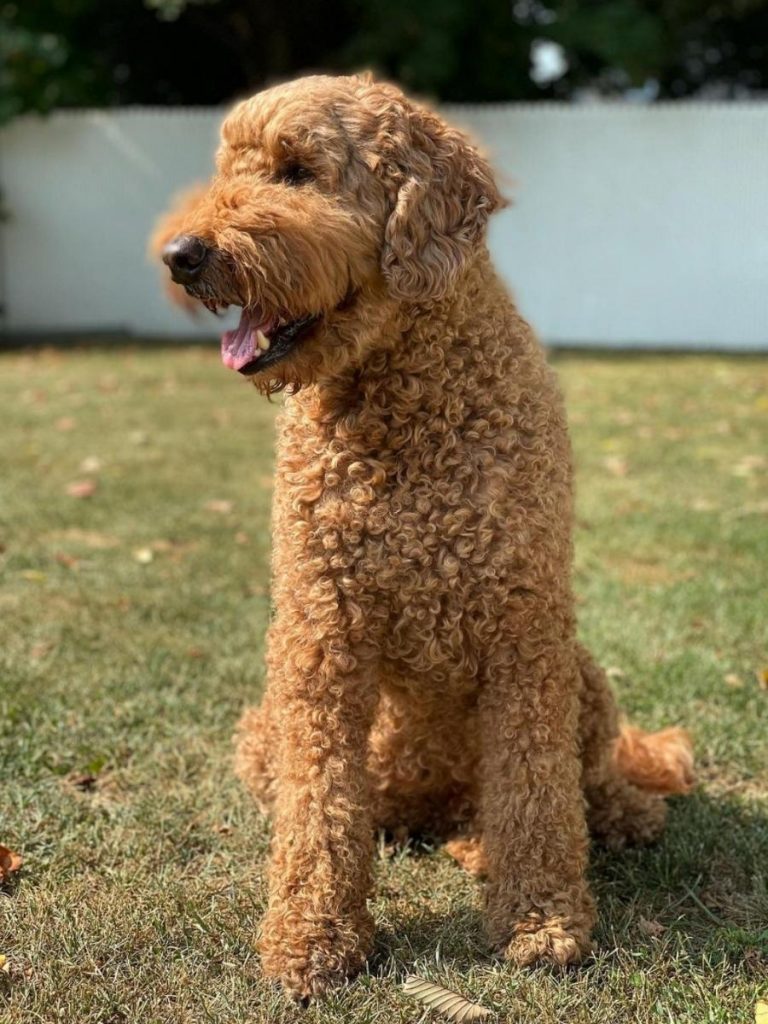
Straight
Straight coats are designated by R/R, which is a pair of straight hair alleles. Even though wild, frizzy fur is what first comes to mind when thinking about Doodle dogs, they can have straight hair with no curls or waves.
Straight coats are rare and despite not having the iconic curly-haired look of a Doodle, these pups still are cuter than heck.
Wire
Poodles technically have wire coats, which is designated by W/W. Wire coats have a rough, or coarse, texture. The wire phenotype is mutually inclusive with the other coat-type phenotypes such as wavy, curly, and straight.
This means that a Doodle dog can have both a wiry coat and a wavy coat, or a non-wiry coat and a wavy coat. This combination is possible for all three coat types as shown in the table below:
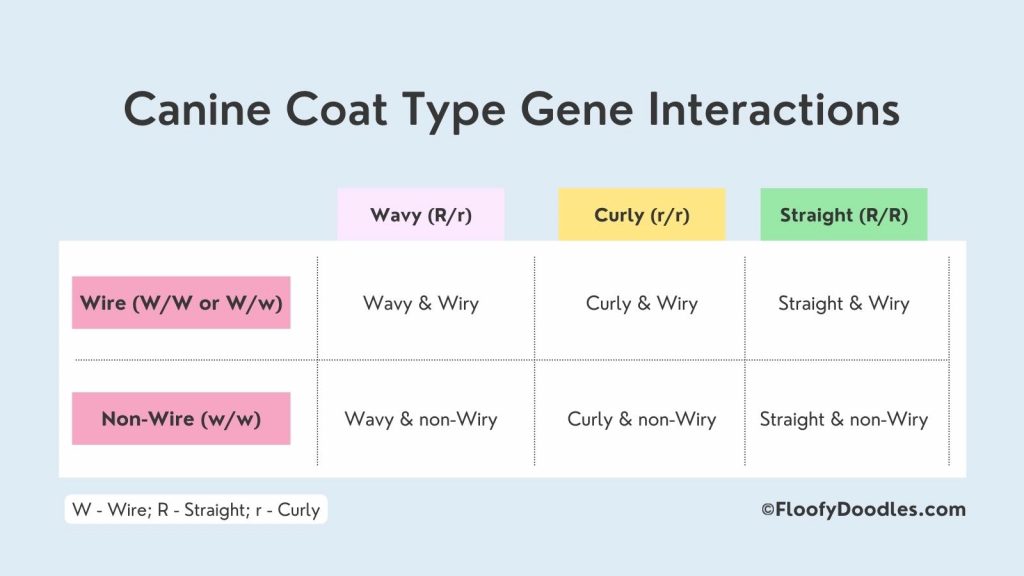
Wire coats are common amongst Terriers, so when a Poodle mixes with a Terrier the odds are high that the resulting Doodle puppy will have a wiry coat. A Whoodle, for example, is a Soft-Coated Wheaten Terrier mixed with a Poodle.
Whoodles typically have a coarse, wavy coat that is due to the wire- and curl-coat combination from the parents.
Color
Doodles come in all sorts of different colors. This is due to the vast array of colors that Poodles can come in. In this section, we’ll take a look at the full Poodle-palette.
Poodle Colors
Doodle breeds can come in just about any color that is present in the dog world. The variation in coat color is much more expansive than the coat-type interactions laid out in the previous section. There are more color variations in the canine genome than there are coat types.
Lets begin by looking at the coat colors of Poodles. Poodles come in a variety of different colors, both solid and mixed. There are 9 different solid colors, as recognized by the AKC [4]https://www.akc.org/dog-breeds/poodle-standard/:
- Apricot
- Black
- Blue
- Brown (or Chocolate)
- Café-au-lait
- Cream
- Gray
- Silver
- White
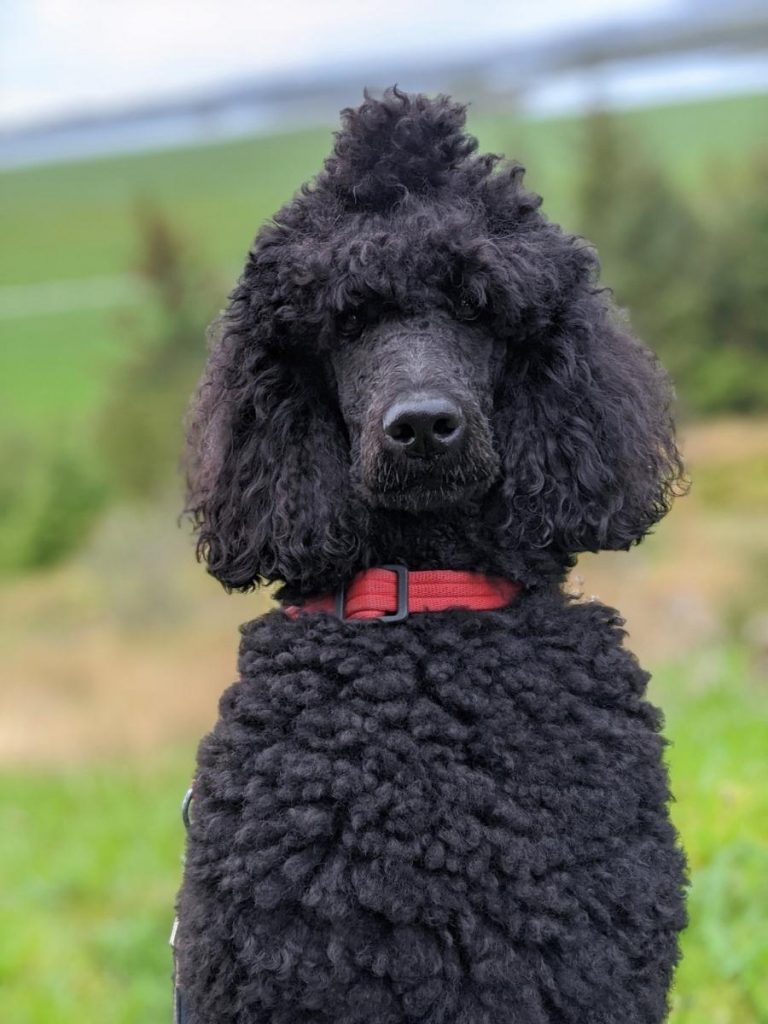
Poodles can also be a mix of these colors. A parti-colored Poodle is a mix of white and another solid color, where white accounts for at least half of the total coloring.
A phantom-colored Poodle has one primary solid color as its base but has splotches of a secondary color in specific regions throughout its body.
Lastly, a Poodle can have abstract coloring, which means a mix of colors that do not satisfy the parti or phantom color rules.

Doodle Colors
Considering the many different colors of Poodles, a Doodle has the potential to be any solid color or a mix of colors. It would be quite exhausting to map out all the possible colors a dog can be based on gene type interactions so for the sake of brevity, I will save you the deep dive.
The color of a Doodle’s coat is influenced by both parent breeds. Therefore, the gene pool changes across the different types of Doodle dogs.
Science says the best method for understanding the different colors of Doodle dogs is by looking at cute pictures of them. So, lets should stick to the scientific method on this one and let’s see a few.
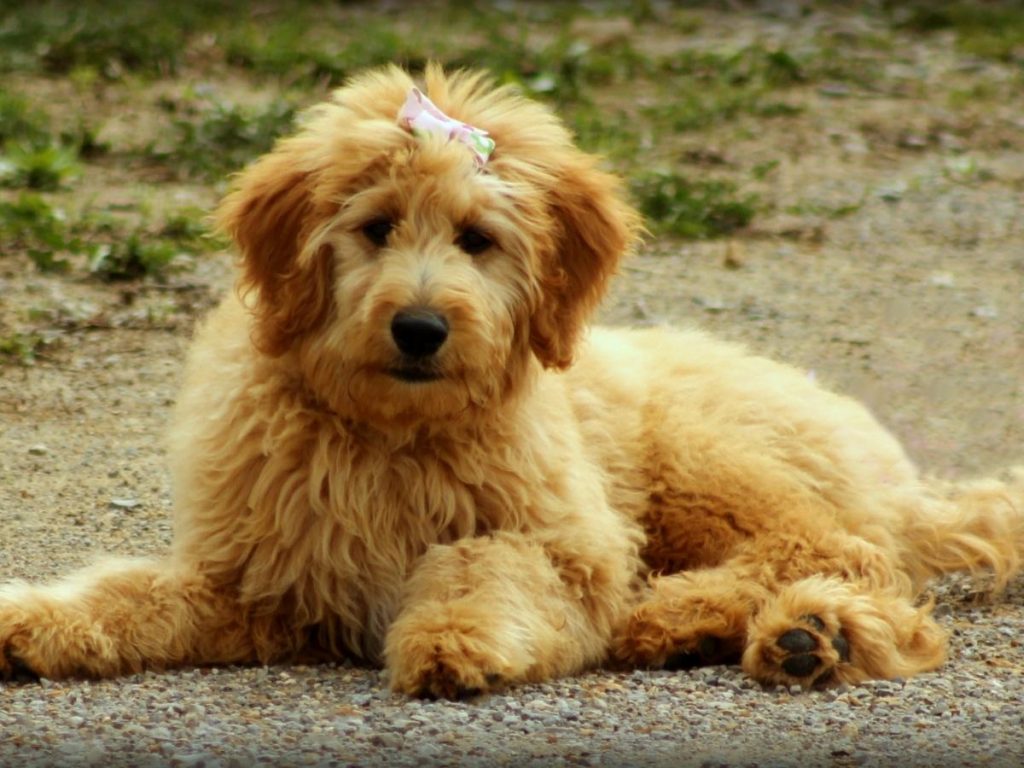

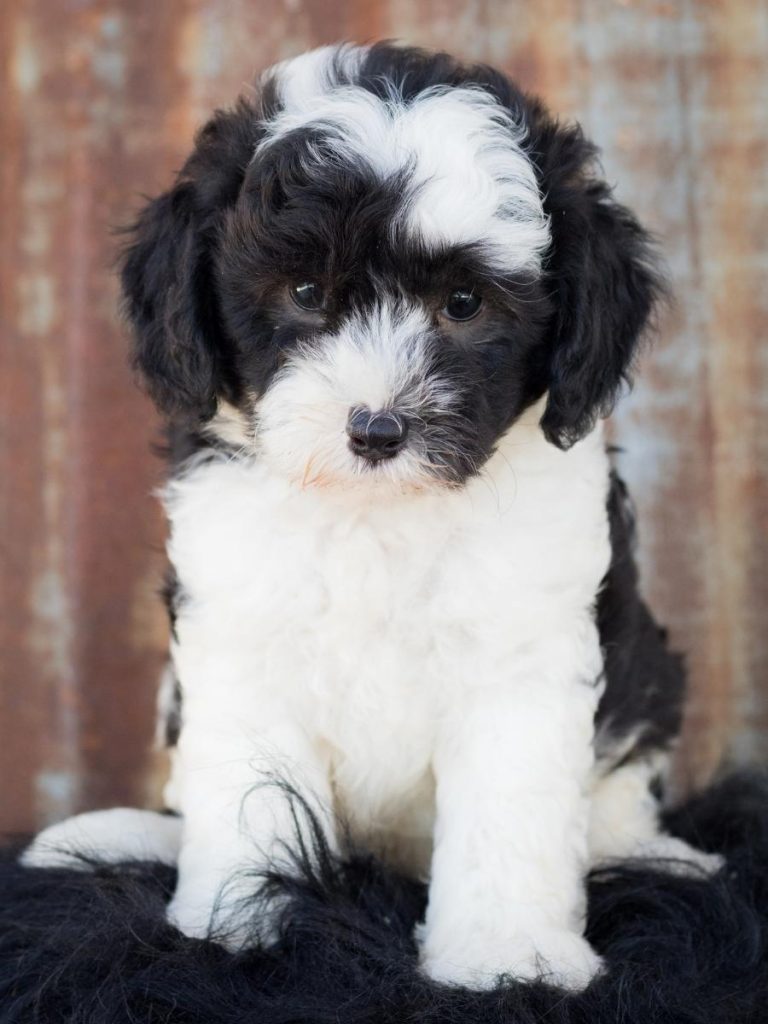


Hypoallergenic
One of the most popular reasons people are attracted to Doodle dogs is their hypoallergenic, low-shedding coats. This trait is credited to the Poodle, which is known for minimal shedding.
Dog hair can exacerbate allergies in many people, so a low or non-shedding Doodle can be a great solution to this problem.
It is important to note that not all Doodle breeds are guaranteed to be hypoallergenic or low-shedding. This is dependent on genetic factors inherited from the parent breeds. However, the odds of a Doodle breed type being hypoallergenic can be increased through selective breeding methods.
Size
Doodle dogs come in all shapes and sizes. Some are absolutely giant while others are incredibly tiny. The large variation in size makes sense considering all of the different types of Doodle dogs out there.
The type of Poodle used to breed a Doodle is an important factor in the size equation. If you are looking for Doodle puppies, knowing the size of the Poodle that was either the parent or grandparent can help provide an estimate for the dog’s size as an adult.
Let’s take a look at the different sizes of Poodles. They can be classified into three sizes: Toy, Miniature, and Standard.
Standard
Standard Poodles range in weight from 40-70 pounds and stand over 15 inches tall [5]https://www.akc.org/dog-breeds/poodle-standard/. Standard Poodles are used to create the popular, household name Doodles such as Labradoodles and Goldendoodles.
Miniature
Miniature Poodles, or Mini Poodles, are much smaller than the Standard Poodle. Miniature Poodles range in weight from 10-20 pounds and are 10-15 inches tall [6]https://www.akc.org/dog-breeds/poodle-miniature/.

They are becoming quite popular in the Doodle world since they produce Doodles that are much smaller in size but with all the same great qualities. Some examples include the Mini Goldendoodle, the Mini Bernedoodle, and the Mini Sheepadoodle.
Toy
Toy Poodles are the smallest of the bunch, hence the name. They range in weight from 4-6 pounds and are less than 10 inches in height [7]https://www.akc.org/dog-breeds/poodle-toy/.
There are Toy Doodles out there – one, in particular, is the Toy Goldendoodle. Toy Poodles, or Toy Doodles, can also be referred to as Teacup Poodles/Doodles.
Size Comparison: Choodle vs Mastidoodle
Since all sizes of Poodle can be crossed with virtually any other dog breed, Doodle breeds have the potential to come in any size imaginable. To drive this point home, let’s look at an example of two Doodle breeds that are complete opposites in size: the Choodle and the Mastidoodle.
The Choodle is a Chihuahua mixed with a Poodle. Chihuahuas are itty-bitty. They range from 4-6 pounds, similar to a Toy Poodle. When you mix these two, they end up being (you guessed it) 4-6 pounds. This makes 5 pounds the average size of a Choodle. For reference, a gallon of milk weighs just over 8 pounds.
The Mastidoodle is a mix between an English Mastiff and a Poodle. English Mastiffs are massive. They range anywhere from 120-230 pounds. An English Mastiff and a Standard Poodle produce a dog that is well over 100 lbs. Averaging the two breeds would give us a pup that is a solid 150 lbs.
The range in size between types of Doodle dogs is explained perfectly in the fact that it would take thirty Choodles to equal the weight of one Mastidoodle.
My money would be on the thirty Choodles if that were a bet. Those little guys don’t mess around!
Temperament
Generally speaking, Doodle dogs have a very agreeable temperament. The mix brings out the best from the two parent breeds; however, the exact temperament will vary across the types of Doodle dogs.
Poodles are highly intelligent, social, and playful. They are alert and ready to protect if the situation calls for it, but overall, they have a gentle and agreeable temperament. The combination of these traits makes them excellent family dogs. The combination of these traits also makes them ideal candidates as service dogs.
When these traits are mixed with other dog breeds, the result is often a unique pup that captures the best traits from both parents. Doodles are known to be very playful, sociable, and good with children.
It is important to note that a dog’s temperament is also affected by its environment and upbringing. Dogs raised in hostile or inhumane conditions tend to be aggressive and anti-social regardless of their breed’s natural temperament. If they were not socialized, or trained, well during puppyhood then the odds of having a disagreeable temperament are increased significantly.
Health
Purebred dogs are prone to genetic diseases inherent to their breed. Crossbreeding, or mixing can mitigate the risk of genetic or hereditary diseases. Therefore, Doodles are often at a lower risk of suffering from a breed-specific disease when compared to their purebred counterpart.
It should be noted that this is not a guarantee. Doodles, like all dogs, still run the risk of being afflicted by a multitude of diseases. Some of the more common issues that are seen in Doodles are:
- Hip dysplasia
- Adenitis
- Addison’s disease
- Subvalvular aortic stenosis
If you’re looking to adopt a Doodle dog or buy a Doodle puppy, you should familiarize yourself with any health issues that are common to the parent breed.
What to consider when buying a Doodle?
There is nothing more exciting than looking for puppies. I lied, the only thing more exciting is looking for Doodle puppies.
If you are on the hunt for a new Doodle puppy to add to your family, there are three important things to consider: price, breeder, and Doodle breed.
Price
In general, Doodle dogs are expensive. Since they are highly sought after and are unique designer dogs, a Doodle from a quality breeder can cost anywhere between $500 to over $5,000.
The price is mainly dependent on three factors: coat color, breeder, specific breed.

Coat Color
If you are considering buying a Doodle puppy, the effect that coat color has on price might take you by surprise (it sure did for me).
The budget was my biggest constraint when I was searching for a Doodle puppy, so it was imperative that I found one at a reasonable price from a reputable breeder.
I considered Labradoodles, Goldendoodles, Aussiedoodles, and Bernedoodles. The one common trend that I found amongst all of the Doodle puppies for sale, was the difference in price based on coat color.
At the time of my search, a tri-colored Bernedoodle was 3x the price of a solid-colored one! Even Bernedoodles that had just a splash of a secondary color were marked at a premium compared to their mono-colored counterparts.
My Bernedoodle, Murphy, came from a litter that had black and white coats. The base color for all the puppies was black. Most, if not all, had splashes of white throughout their coats. The puppies that had more white regions sold at a higher cost than those that did not.
This is a trend in the Doodle world. Doodles that have more than one color will be more expensive than those with just one solid color. The effect is magnified if there are three colors or unique markings.
Breed
The breed is an important component to consider. No dog breed is the same, which means that characteristics such as temperament and health can vary drastically across Doodle breeds.
You must do your due diligence on the different Doodle breeds out there before purchasing one. Since the Poodle is the staple parent or ancestor, in all Doodle breeds it is worthwhile to investigate their characteristics along with the traits of the other parent breed.
For example, a Golden Retriever is vastly different from a Soft-Coated Wheaten Terrier. One was bred for hunting in Scotland, while the other was bred to help around the farm in Ireland. Therefore, a Goldendoodle will have different traits and characteristics than a Whoodle.
Due to the variance between dog-breeds, I am confident there is a Doodle for everyone.
Breeder
The breeder is arguably the most important factor when it comes to choosing a Doodle puppy. A high-quality breeder will ensure the dog will have the right start to a long, healthy, and happy life. Contrarily, a low-grade breeder will not give too much thought to the dog’s wellbeing so long as they get paid.
As a prospective Doodle dog owner, you simply want to bring home an adorable puppy of your choosing. If you can do so without breaking the bank, then it’s a win-win right?
Wrong.
As a new college grad, saddled with student loans, I was stuck in this exact situation. I was looking for a cute Doodle puppy that I could afford – and I couldn’t afford much. I found a few litters of different Doodle breeds that were nearly half the price of other Doodle puppy litters.
Naturally, I thought I hit the jackpot. I reached out to these breeders and received some suspect responses. Luckily, at the time, I was reading a book on dog ownership and it harped relentlessly on the importance of finding a good, quality breeder and avoiding puppy mills at all costs.
But what exactly is a puppy mill? Continue to the next section to find out.
Puppy Mills
A puppy mill is a breeder, or business, that continuously raises litters of puppies as cheaply and quickly as possible for the sole purpose of making a profit.
At first, I thought the term ‘puppy mill’ was referencing some type of windmill that was powered by puppies. It turns out in the magical world of cute, cuddly puppies there is a monster lurking in the shadows that preys on naïve potential dog owners.
If you are looking for a Doodle puppy, you must stay far away from a puppy mill. Unfortunately, the popularity of Doodle dogs has attracted some shady characters that want a piece of the action. When I say action, I mean money.
Operators of puppy mills try to make a quick profit by taking advantage of dogs that are trending. The popularity of Doodle breeds makes them a prime target for puppy mills.
These shady characters will breed Doodle puppies, and lots of them, in an inhumane environment. They have no concern about the welfare of the dogs and will generally try to sell at a lower cost since they are constantly having new litters.
The low cost attracts potential customers because they don’t want to shell out thousands for a new Doodle puppy. This is completely understandable given the high prices that Doodle puppies sell at. Unfortunately, this decision will end up costing big time in the long run.
Puppy mills produce dogs that have medical and temperament issues that can and will stick around for the lifetime of the dog.
People believe they are “saving” the dog from the mill – I mean come on look at that adorable face. In reality, it just is lining the pockets of these scum bags which enables them to repeat the process in the future.
Bottom line: if you’re looking for a happy and healthy Doodle dog, then avoid puppy mills at all costs!
Quality Breeders
A quality Doodle dog-breeder takes pride in ensuring the puppies, and their parents, are healthy, happy, and raised with care.
Quality breeders, in general, are more expensive but they are worth their weight in gold. A reputable breeder will have experience and a passion for raising puppies. A good breeder is not in it to make a quick dollar but rather to enable others to share in the magnificent gift of dog ownership.
A Doodle puppy has a much better start to life when raised diligently and compassionately. A quality breeder will ensure the parents are perfectly fit for breeding, which leads to a litter of healthy puppies.
A good breeder will make sure the puppies are well socialized, with other dogs and with people. An excellent breeder will even be sure to socialize the pups with children. This takes a massive burden off you since your new dog will be confident and comfortable in the world.
In the long run, your dog is less prone to temperament and health issues if they come from a good breeder. This will save you money and stress throughout the dog’s life.
You also get the added satisfaction that you didn’t support a shady puppy mill.
Types of Doodle Breeds
Today, there are many types of Doodle breeds out there. The official number of Doodle breeds isn’t exactly clear. The number varies anywhere from 40 up to 111 breeds!
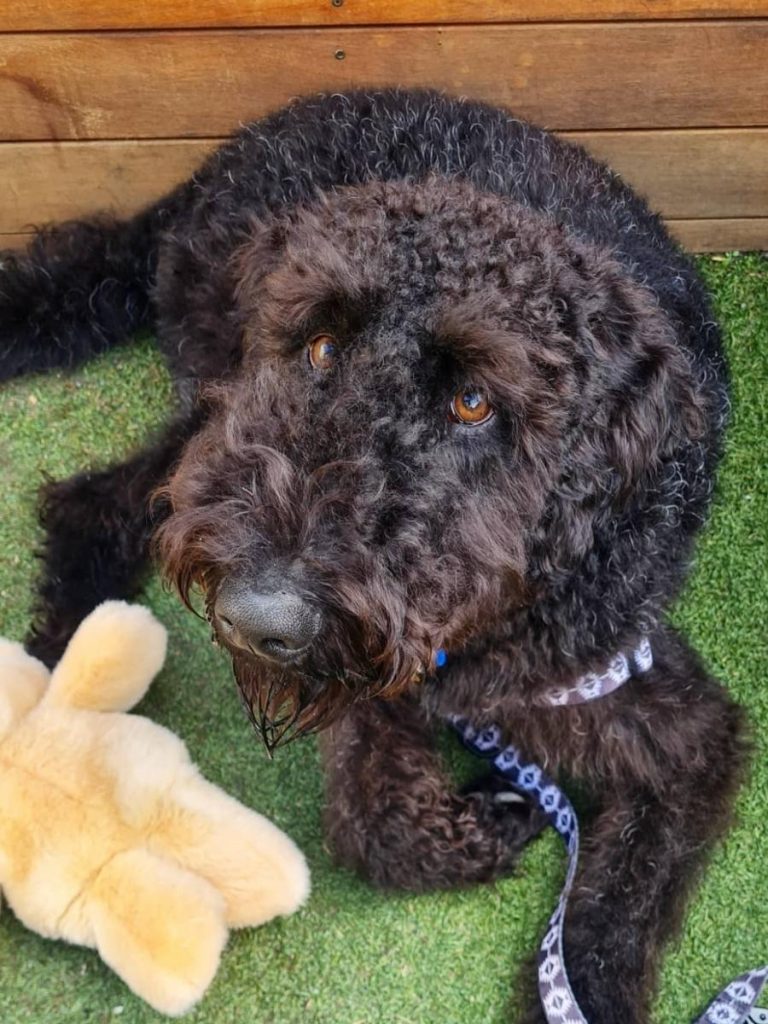
As Doodles continue to rise in popularity, it will not be a surprise to see the number of different types of Doodle breeds increase. Currently, there are over 300 recognized dog breeds [8]https://www.prudentpet.com/newest-purebred-cross-breeds/. If a Poodle is mixed with each type, then that would make over 300 different types of Doodle breeds!
Goldendoodles and Labradoodles receive a lot of attention as the two most popular Doodle breeds today. But, there are plenty of other Doodle breeds out there that are just as great.
For example, here is a list of 50+ different types of Doodle dogs (not counting the miniature versions):
- Affenpoo (Affenpinscher and Poodle)
- Airedoodle (Airedale Terrier and Poodle)
- American Bulldoodle (American Bulldog and Poodle)
- Anadoodle (Anatolian Shepherd and Poodle)
- Aussiedoodle (Australian Shepherd and Standard Poodle)
- Mini Aussiedoodle (Australian Shepherd and Mini Poodle)
- Australian Labradoodle (Cocker Spaniel, Labrador Retriever, and Poodle)
- Basenjidoodle (Basenji and Poodle)
- Bassetdoodle (Bassett Hound and Poodle)
- Belgian Doodle (Belgian Sheepdog and Poodle)
- Black Mouth Curdoodle (Black Mouth Cur and Poodle)
- Bloodhoodle (Bloodhound and Poodle)
- Bernedoodle (Bernese Mountain Dog and Poodle)
- Mini Bernedoodle (Bernese Mountain Dog and Mini Poodle)
- Bidoodle (Bichon Frise and Poodle)
- Bolonodoodle (Bolognese and Poodle)
- Bordoodle (Border Collie and Poodle)
- Boxerdoodle (Boxer and Poodle)
- Broodle Griffon (Brussels Griffon and Poodle)
- Cadoodle (Collie and Poodle)
- Cairnoodle (Cairn Terrier and Poodle)
- Canoodle (Cane Corso and Poodle)
- Choodle (Chihuahua and Poodle)
- Cotondoodle (Coton de Tulear and Poodle)
- Doberdoodle (Doberman and Poodle)
- Doxiedoodle (Dachshund and Poodle)
- English Goldendoodle (English Golden Retriever and Poodle)
- English Labradoodle (English Labrador Retriever and Poodle)
- English Setterdoodle (English Setter and Poodle)
- Flandoodle (Bouvier des Flandres and Poodle)
- Foodle (Fox Terrier with Poodle)
- French Bulldoodle (French Bulldog with Poodle)
- Goldendoodle (Golden Retriever and Poodle)
- Mini Goldendoodle (Golden Retriever and Mini Poodle)
- Golden Mountain Doodle (Golden Retriever, Bernese Mountain Dog, and Poodle)
- Great Danoodle (Great Dane and Poodle)
- Huskydoodle (Siberian Husky and Poodle)
- Irish Doodle (Irish Setter and Poodle)
- Irish Troodle (Irish Terrier and Poodle)
- Labradoodle (American Labrador Retriever and Poodle)
- Mini Labradoodle (American Labrador Retriever and Mini Poodle)
- Mastidoodle (English Mastiff and Poodle)
- Malinoodle (Belgian Malinois and Poodle)
- Pit Boodle (Pit Bull and Poodle)
- Pyredoodle (Great Pyrenees and Poodle)
- Ratoodle (Rat Terrier and Poodle)
- Rhodoodle (Rhodesian Ridgeback and Poodle)
- Saint Berdoodle (Saint Bernard and Poodle)
- Salukidoodle (Saluki and Poodle)
- Schnoodles (Schnauzer and Poodle)
- Scoodle (Scottish Terrier and Poodle)
- Sheepadoodle (Sheepdog and Poodle)
- Sheltiedoodle (Shetland Sheepdog and Poodle)
- Shepadoodle (German Shepherd and Poodle)
- Spanish Water Doodle (Spanish Water Dog and Poodle)
- Springerdoodle (English Springer Spaniel and Poodle)
- Tiboodle (Tibetan Spaniel and Poodle)
- Ttoodle (Tibetan Terrier and Poodle)
- Vizsladoodle (Vizsla and Poodle)
- Weimardoodle (Weimaraner and Poodle)
- Whoodle (Soft-Coated Wheaten Terrier and Poodle)
- Mini Whoodle (Soft-Coated Wheaten Terrier and Mini Poodle)
- Whipoodle (Whippet and Poodle)
- Woodle (Welsh Terrier and Poodle)
Conclusion
The Doodle dog breed craze has only just begun. Doodles have come a long way from their inception as hypoallergenic service dogs in 1989. They are now highly sought-after designer breeds that have a strong foothold in modern culture.
It is no wonder these dogs have had an incredible rise in popularity considering their list of attributes: funny personalities, excellent traits, hypoallergenic properties, low-shedding fur, and otherworldly cuteness.
Now it’s time to start searching for Doodle puppies for sale or Doodle dogs for adoption near you!
FAQ
Are Doodles good service dogs?
Doodles are popular candidates for service-based roles, such as therapy or guide dogs. They are also very popular as family dogs. The idea that they can have multiple roles is one of the many reasons why these dogs are highly sought after.

References


